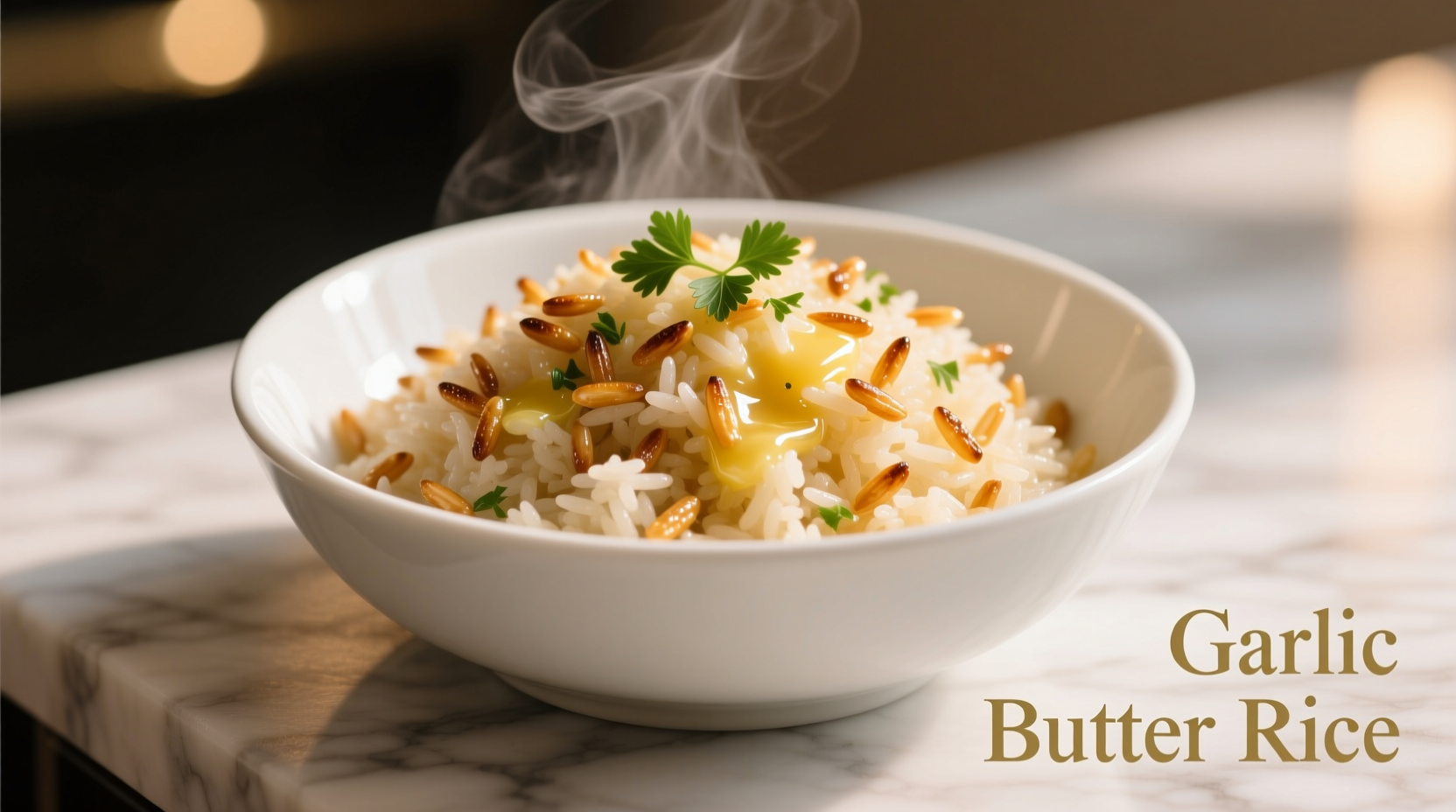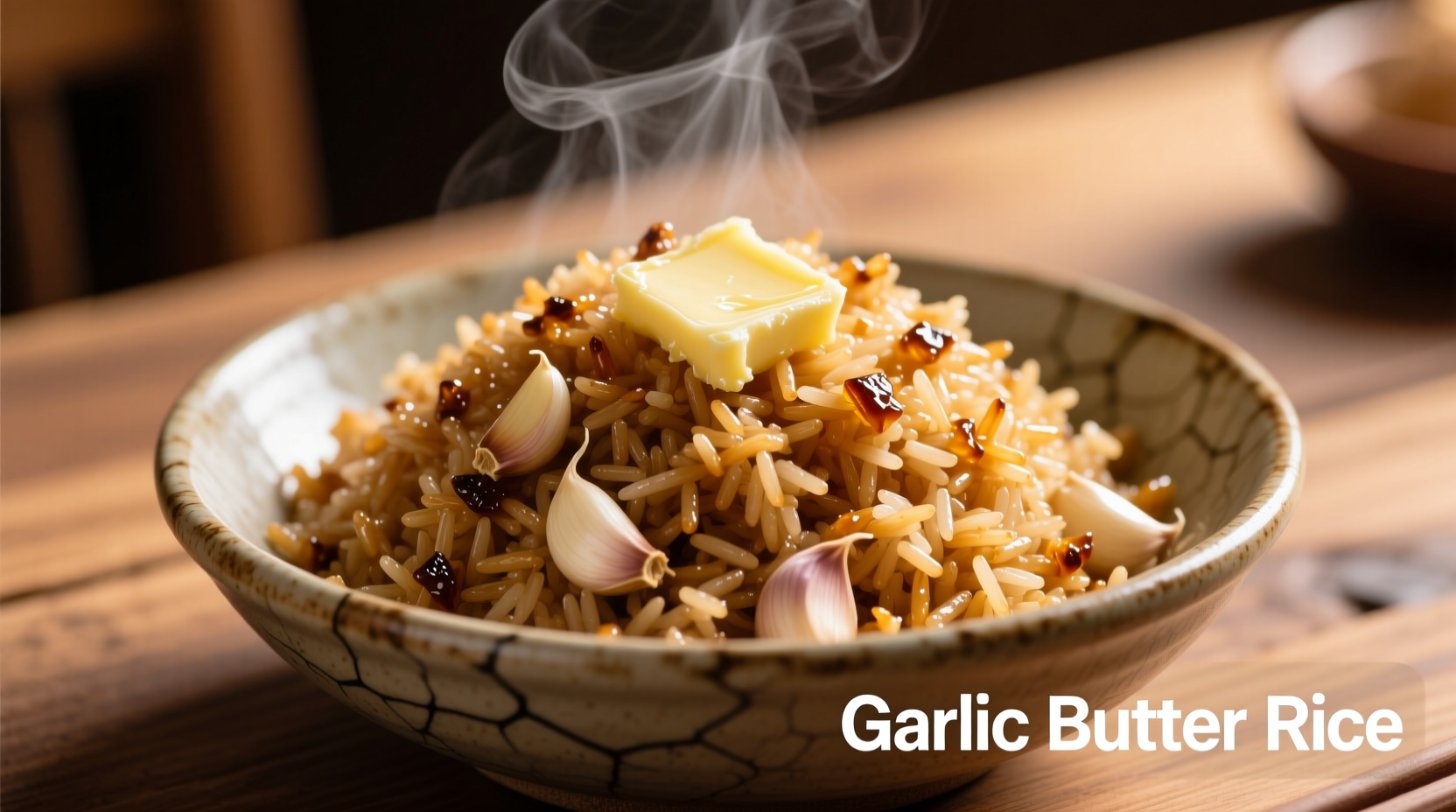The Essential Garlic Butter Rice Recipe
Creating exceptional rice with garlic and butter requires more than just following basic instructions. The magic happens when you understand the precise timing, ingredient ratios, and technique nuances that separate ordinary from extraordinary. This foundational recipe serves as your starting point for mastering this versatile side dish that complements countless main courses.
Why This Simple Combination Works So Well
The chemistry behind rice with garlic and butter reveals why this pairing creates such satisfying flavor. When butter melts, its milk solids caramelize slightly, creating nutty undertones that complement rice's natural starchiness. Garlic's sulfur compounds transform when heated, mellowing their sharpness while developing complex aromatic compounds that infuse the entire dish. According to food science research from the Culinary Institute of America, the fat in butter helps carry and distribute garlic's volatile flavor compounds more effectively throughout the rice grains.
Step-by-Step Cooking Process
Preparation Phase: Setting Up for Success
Begin with these critical preparation steps that most home cooks overlook:
- Rinse your rice thoroughly until water runs clear to remove excess surface starch that causes clumping
- Use a 1:1.5 rice-to-water ratio for most long-grain varieties (adjust for specific rice types)
- Let rice rest for 20 minutes after rinsing to allow surface moisture to evaporate
- Mince garlic finely or use a microplane for even distribution without burning
Cooking Phase: Precision Timing Matters
The cooking process requires careful attention to timing:
- Melt 2 tablespoons of unsalted butter in a heavy-bottomed pot over medium heat
- Add 3-4 minced garlic cloves and sauté for 60-90 seconds until fragrant but not browned
- Add 1.5 cups rinsed rice and toast for 2 minutes, stirring constantly
- Pour in 2.25 cups water or broth and bring to a gentle boil
- Reduce heat to lowest setting, cover tightly, and cook for 15-18 minutes
- Remove from heat and let rest, covered, for 10 minutes before fluffing
- Stir in 1 additional tablespoon of cold butter just before serving
Finishing Touches: Elevating Your Dish
Professional chefs add these finishing techniques that make a noticeable difference:
- Resting period allows steam to finish cooking the rice evenly and prevents mushiness
- Cold butter addition at the end creates a subtle sheen and enhances mouthfeel
- Fluff with fork rather than spoon to maintain grain integrity
- Add fresh herbs like parsley or chives just before serving for brightness

Common Mistakes and How to Avoid Them
Even experienced cooks make these frequent errors when preparing rice with garlic and butter:
- Adding garlic too early - Garlic burns quickly; add it after the butter has melted but before the rice
- Peeking during cooking - Each time you lift the lid, you release valuable steam that disrupts cooking
- Using salted butter - Makes it difficult to control overall salt content of the dish
- Skipping the resting period - Results in unevenly cooked or mushy rice
Rice Variety Comparison for Garlic Butter Preparation
| Rice Type | Water Ratio | Cooking Time | Best For |
|---|---|---|---|
| Basmati | 1:1.5 | 15-17 min | Light, fragrant dishes; Indian/Middle Eastern cuisine |
| Jasmine | 1:1.4 | 14-16 min | Slightly sticky texture; Southeast Asian dishes |
| Long Grain White | 1:1.5 | 16-18 min | Most versatile; works with any cuisine |
| Brown Rice | 1:2 | 35-40 min | Heartier texture; requires pre-soaking for best results |
Historical Evolution of Garlic Butter Rice
While simple in preparation, garlic butter rice has an interesting culinary journey. According to food historians at the Oxford Symposium on Food and Cookery, garlic-rice combinations date back to ancient Mediterranean civilizations where both ingredients were staples. The addition of butter rather than olive oil became prominent in European preparations during the 17th century when dairy farming expanded across northern Europe. In America, garlic butter rice gained popularity through French culinary influence in the 19th century, particularly in New Orleans where it became a standard accompaniment to Creole dishes. Today, this preparation method has been adapted across global cuisines, with each culture adding distinctive touches while maintaining the core garlic-butter-rice foundation.
Practical Variations for Different Needs
Adapt this basic recipe to suit various dietary requirements and flavor preferences:
- Dairy-free version: Substitute butter with high-quality olive oil or vegan butter alternative
- Garlic intensity control: Roast whole garlic cloves for milder flavor or use garlic powder for consistent distribution
- Herb-infused variation: Add fresh thyme or rosemary during the toasting phase
- Lemon-garlic butter rice: Stir in 1 tablespoon fresh lemon juice with the final butter addition
- Cheesy garlic butter rice: Fold in 2-3 tablespoons of finely grated parmesan after cooking
When Garlic Butter Rice Works Best (and When It Doesn't)
Understanding the appropriate culinary context enhances your cooking success. Food anthropologists at Cornell University's Food and Brand Lab note that garlic butter rice serves as an ideal accompaniment when:
- Paired with simply prepared proteins like grilled chicken, fish, or steak
- Serving as a base for saucy dishes where the rice absorbs flavors
- Complementing roasted vegetables that share similar flavor profiles
However, this preparation may not work well when:
- Serving with strongly spiced dishes that would compete with the garlic notes
- Accompanying delicate seafood that requires more subtle flavors
- Used as a base for Asian-inspired stir-fries that typically use different rice preparations
Serving and Storage Guidelines
For optimal enjoyment and food safety:
- Serving temperature: Serve immediately after the resting period for best texture
- Leftover storage: Cool completely within 2 hours, then store in airtight container for up to 4 days
- Reheating method: Add 1-2 teaspoons water per cup of rice and steam gently rather than microwaving dry
- Revitalizing leftovers: Stir in fresh butter and garlic when reheating to restore flavor
The FDA Food Code specifies that cooked rice should not remain in the temperature danger zone (40°F-140°F) for more than 2 hours to prevent bacterial growth, particularly from Bacillus cereus which can survive cooking temperatures.
Professional Chef Tips for Consistent Results
Based on my experience working in professional kitchens, these advanced techniques elevate your garlic butter rice:
- Butter temperature control: Use room temperature butter for even melting without burning
- Garlic preparation: Soak minced garlic in cold water for 5 minutes before use to reduce burning risk
- Pot selection: Use a heavy-bottomed pot with tight-fitting lid for even heat distribution
- Water quality matters: Filtered water produces cleaner-tasting rice than chlorinated tap water
- Resting is non-negotiable: The 10-minute rest after cooking completes the steaming process











 浙公网安备
33010002000092号
浙公网安备
33010002000092号 浙B2-20120091-4
浙B2-20120091-4